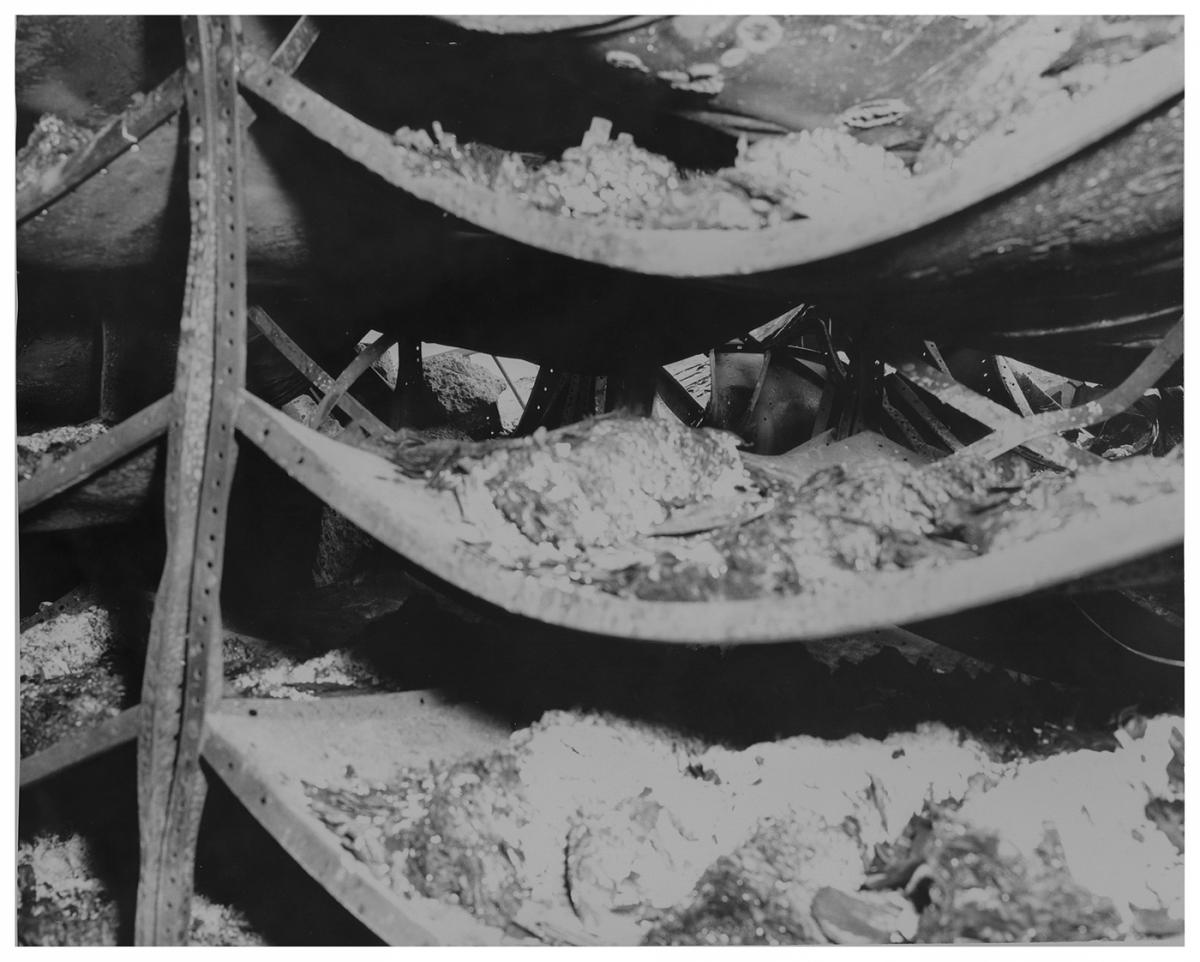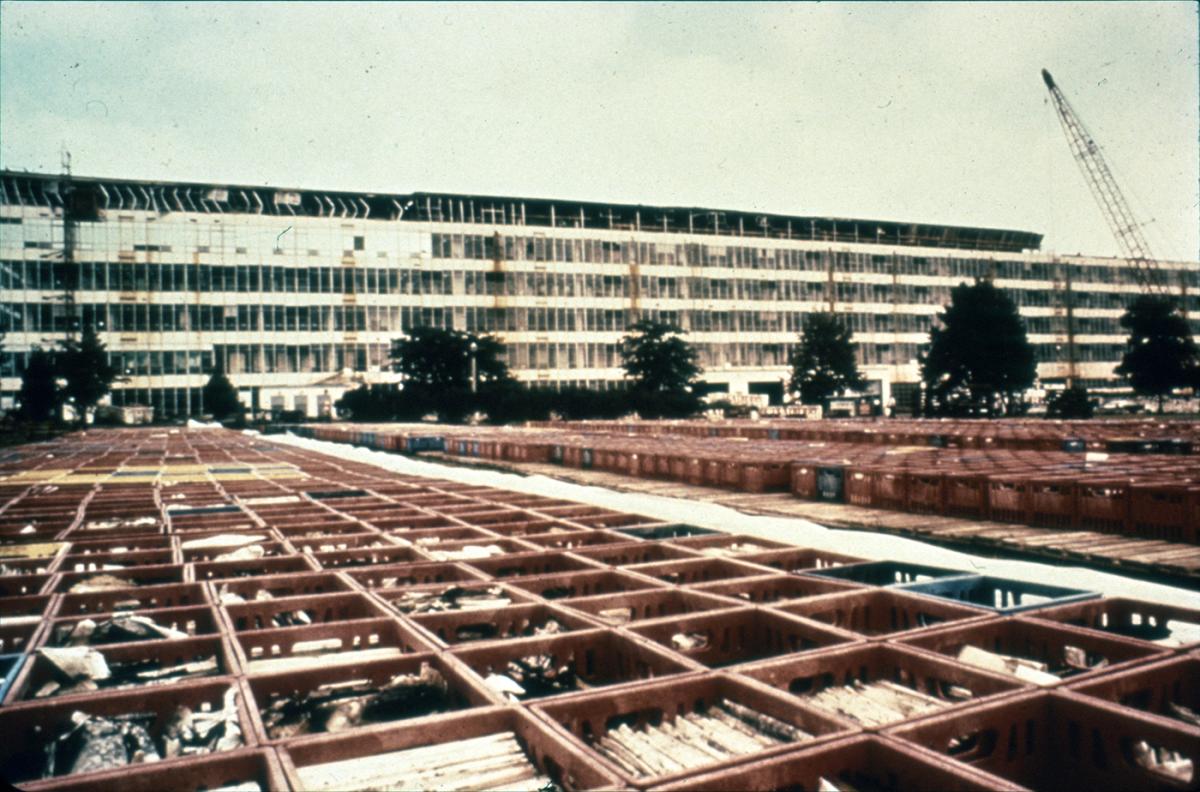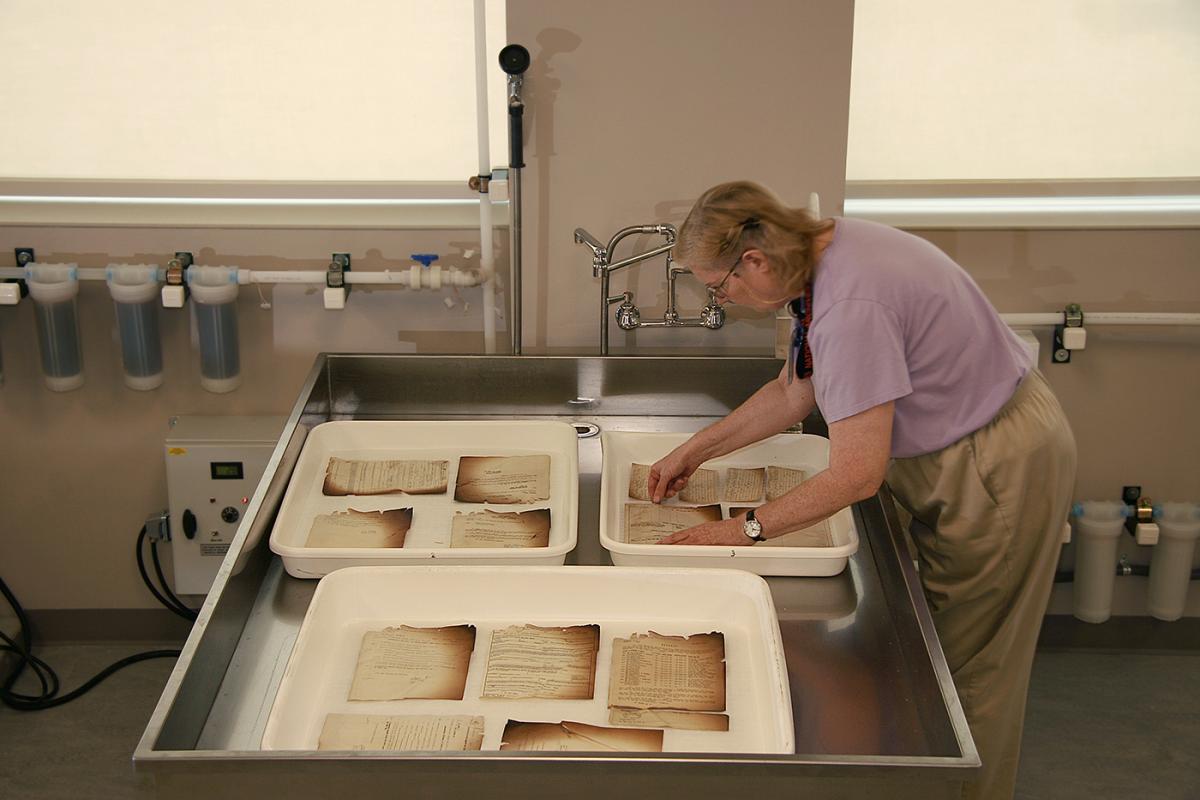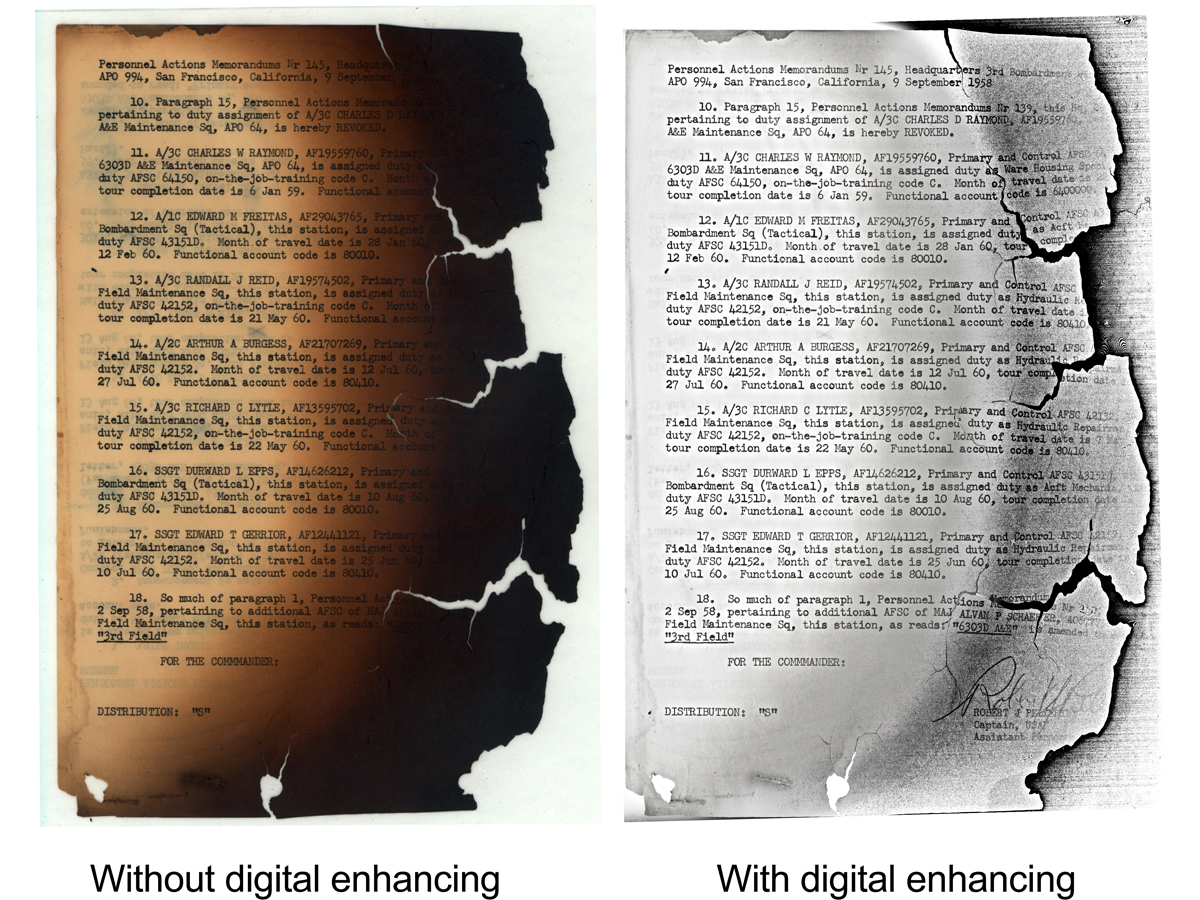
Burnt in Memory
Looking back, looking forward at the 1973 St. Louis fire
Spring 2013, Vol. 45, No. 1
By Marta G. O’Neill and William Seibert
A few minutes past midnight on July 12, 1973, a fire broke out at the National Personnel Records Center (NPRC) in the suburbs of St. Louis.
At risk was an untold amount of information about Americans who had served in the armed forces in the 20th century.
The center, known as the Military Personnel Records Center (MPR), held about 22 million personnel files of former members of the Army, Army Air Force, and Air Force who served between 1912 and 1963. The fire destroyed vast numbers of these unique records—and its immense impact on U.S. citizens, their rights, and entitlements continues to this day.
But the fire’s devastation also shifted the paradigm for fire prevention, for records storage, and records emergency response in this country.
Out of its ashes emerged strategies for the recovery of wet and fire-damaged records, a better understanding of assessing risks that threaten records, and the conviction that sprinkler fire suppression is mandatory for almost all records.
The Department of Defense constructed the Center in the mid-1950s to bring together the huge volume of 20th-century military personnel records that had accumulated up to that time.
The designers hired by the Pentagon visited existing record centers and encountered two schools of thought on records protection: “fire is evil” and “water is evil.”
The Navy records center in Garden City, New York, had sprinklers as a fire safety precaution; the Defense Department facility in Alexandria, Virginia, did not. Senior officials in Alexandria strongly asserted that water damage was more likely to occur from flooding, broken pipes, and leaks. The new St. Louis facility did not include sprinklers. It later became clear that the risk and consequences of complete destruction by fire was significantly greater than the potential for partial damage by water.
A second fundamental flaw exacerbated this decision to omit sprinklers for fire suppression. The building mixed records storage with work areas, with only a single concrete wall separating offices from records. The more than 200,000 square feet of open records storage had no fire barriers to contain a fire and limit the extent of its damage on any of its six floors.
A hopeful step forward came in 1973, as the General Services Administration was in the early stages of awarding a contract to retrofit the facility with sprinklers and smoke detectors. But the building still was without sprinklers and smoke detectors by July 1973.
Planning the Recovery After Massive Losses
Bad fortune struck minutes past midnight on the night of July 12, 1973, when a fire alarm sounded at the North Central County Fire Alarm System. The time was 12:16:15 a.m.
By the time the fire reached its peak, 42 fire districts were fighting it. The fire burned uncontrolled for more than 22 hours. Four days later, on the morning of July 16, fire department officials declared the fire out, but it was several more days before all hot spots were extinguished. The millions of gallons of water poured on the top floor stopped the spread of fire to floors below, but it increased the water damage to records there. Water pipes that broke during the fire continued to flood the building until the pipe runs could be located and closed.
A comprehensive survey of damage and plans for recovery effort began immediately.
The first visit to the sixth floor revealed total destruction. Reinforced concrete columns had sheared off, causing the roof to collapse. Metal shelving and metal filing cabinets were bent and twisted by the fire’s heat. Bricks of ash remained where cubic foot boxes of records once sat. Aisles between shelving rows were filled with debris up to three feet deep, and several inches of water covered the floor.
The damage and loss of records was heartbreaking.
Of approximately 22 million individual Official Military Personnel Files stored on the sixth floor, roughly 16 to 18 million—73 to 80 percent—were lost. The losses can only be estimated because the records were not indexed, and no computer registry or database existed for the unique records. Adding to the chaos and challenges of the aftermath of the fire were the high humidity and summer heat typical of St. Louis, an environment ripe for mold growth.
Nevertheless, a plan for records salvage took shape. On the sixth floor, front loaders and backhoes filled dumpster-style bins with debris and records. Large boom cranes lifted mangled shelving, some with boxes still on them, and removed them to ground level.
Finding New Places for Staff to Work
Staff quickly returned to work to begin a variety of recovery efforts. Some staff worked in the adjacent cafeteria building to resume reference work on non-damaged records, while others removed water-saturated records from lower floors. A human chain of workers moved wet boxes to ground level by resting the boxes on the rubber handrails of operating escalators.
Meanwhile, other staff worked in a “tent city” erected on the grounds to sort and rehouse recovered records. At first, records were placed in dry cardboard boxes, but plastic milk crates eventually were discovered to be the most effective means to hold and dry damaged records.
Officials faced a monumental drying task as the volume of wet records to be dried amounted to nearly 90,000 cubic feet. A manual drying operation began at the Civilian Personnel Records Center (CPR) 12 miles to the east, but the process proved both labor intensive and slow. Records were first sprayed with a thymol solution to inhibit further mold growth and then trucked to CPR and laid out on drying racks.
Preservation specialists from the National Archives in Washington and from the Library of Congress went to St. Louis to advise on recovery of the fire- and water-damaged records. A fortunate discovery was that the nearby McDonnell Douglas Aircraft Corporation plant had large vacuum chambers used for the Apollo space program to simulate conditions in outer space. Vacuum technology had not been widely used to dry wet records, but initial tests on the records showed good results. Archives staff ended up using three chambers at McDonnell Douglas as well as a vacuum chamber at the National Aeronautics and Space Administration facility in Sandusky, Ohio.
The vacuum drying technology successfully extracted water, but the recovered records still retained fire and water damage, from warping and buckling caused by water to browning, brittleness, and ash from the fire. Unstable inks had either feathered or disappeared; dirt, soot, and debris clung to the paper; and mold growth abounded.
Continuing to Provide Reference in the Face of Staggering Losses
The fire’s impact has been staggering.
Because of the millions of records involved, it is likely that your or a family member’s records of service have been affected.
The Official Military Personnel File (OMPF) is the most requested record in all NARA facilities around the nation. Approximately half of the daily requests at NPRC in St. Louis are for the veteran’s form DD-214 (separation paper), while the other half are for either the entire file or portions of the file. The NPRC receives an average of 5,000 requests each day and more than one million annually, which represents more than 90 percent of all National Archives reference.
The OMPF provides data needed to ensure that veterans and their families receive benefits, entitlements, or job placement. The majority of OMPF requests are for records to document the veteran’s eligibility for federal benefits and entitlements such as the GI Bill, Veterans Administration health care, and burial in a national cemetery. Many of these requests are time-sensitive, and the necessary record material must be provided within hours to a few days. In addition, military records are valuable sources for genealogy, historical, and other research.
Hardest hit among the losses were approximately 85 percent of the records of Army personnel discharged from 1912 through 1959. Army service has historically accounted for over 50 percent of all U.S. military service. About 75 percent of Air Force personnel files of persons with the surnames “Hubbard” through the letter “Z” were lost, representing personnel discharged from the establishment of the Air Force in 1947 through 1963. Only an estimated 6.5 million records were recovered, many in an extremely fragile state.
The loss of these unique records created a monumental challenge in providing the important data contained in OMPFs to veterans. During the recovery effort, staff inventoried data for each recovered record and entered it into a computerized registry, searchable by the name, Army or Air Force serial number, or the veteran’s date of birth.
At the same time, staff began to collect other sources of information on service in records created or held by military and civilian federal agencies and by state and local governments. These newly acquired holdings, totaling thousands of cubic feet of paper and microfilm materials, are known as “auxiliary” records. Although these records contain only limited military service information, when used together, they can document key aspects of individuals’ military service.
Reorganizing the Staff to Handle Requests for Destroyed Records
A new reference organization—the Records Reconstruction Branch—was established within the NPRC to handle reference requests pertaining to the burned files.
Today, there are two teams of technicians, totaling 32 employees, who work exclusively on fire-related reference requests. On average, these technicians process 2,300 fire-related reference requests a week.
In addition to locating records that survived the fire, these staff members became skilled in finding and using auxiliary records to reconstruct an OMPF. Sometimes organizational records, such as unit rosters and morning reports, or pay records created by the Army Finance Corps sufficed. In many cases, reference technicians obtain copies of or extracts from records held by other government offices.
The most common sources of alternate records have been the Veterans Administration, the Selective Service System, the Army and Air Force Casualty Branches, Judge Advocate General Offices, the American Battle Monuments Commission, State Adjutants General, state archives, and state and county veterans’ service offices.
Using these available alternate information sources, the Records Reconstruction staff can determine a veteran’s beginning and ending dates of active military service, the character of that service, and rank while in service. In some instances, staff can also document time lost while on active duty, unit assignments and duty stations, service overseas, casualty status, periods of hospitalization, awards and decorations received, arm of service, and military occupational specialty.
In a multifaceted, often quite complicated, and time-consuming information-gathering process, the NPRC has reconstructed the basic individual service histories of millions of former Army and Air Force members and provided them a Certification of Military Service (National Archives Form 13038). This document is recognized as the equivalent of the Department of Defense Form 214 (known simply as DD-214), Report of Separation from Active Duty, which is necessary to establish eligibility for veterans’ benefits. These efforts are vital to provide millions of veterans with essential benefits and entitlements.
Preserving Damaged Records, and Finding Storage Space
As burned records were inventoried, they were placed in a separate storage bay in the refurbished building to segregate the brittle, discolored, moldy, and fragile burned records in a controlled temperature. But ongoing demand for the damaged records raised concerns about their survival. In 2000, Congress provided funding to the National Archives to establish a preservation program at NPRC to address preservation issues for these vital records. Today, 40 years after the fire, the NPRC continues to receive about 200 to 300 requests daily for records from the burned holdings, known as the “B-Files.”
The B-files are now stored in special environmentally controlled bays within a new facility in north St. Louis County, which was completed in 2011. The temperature in these bays is kept just above 50° F to minimize further deterioration and reactivation of dormant mold spores. Isolation from regular records storage areas prevents cross-contamination.
When a veteran or family member makes a request, the records are brought to the Preservation Program’s Decontamination Lab, where staff carries out mold remediation treatment.
The first concern in handling these fire-damaged records is to protect personal health. Exposure to mold poses health hazards, as can the soot that settled onto the documents during the fire. Staff use special equipment, including latex and vinyl gloves, respirators, erasers, and HEPA vacuums, and handle the records inside ducted fume hoods, which limit staff exposure to hazardous fumes, vapors, dust, and debris.
Damage varies widely. Some records come to the lab as charred, burned fragments. Others show no sign of burn damage but are fused together or are in the same distorted chunks as when they were first recovered. Many show dry remnants of inactive mold, while others have bits of concrete or other debris hidden in the folds and creases of the papers. Paper is commonly brittle either because of the poor paper quality or because the dramatic heat of the fire “baked” and degraded the paper.
Preservation technicians’ gloved hands seek to separate one page from the other or carefully remove rusted staples. They slip a thin steel microspatula into an opening in a bid to release the fusing. With patient manipulation of the tools and the pages of the record, the technicians can separate individual sheets for the first time in nearly 40 years.
Surface cleaning is the primary task in remediating the mold and soot on these records. The most-used tools are simple: a special vacuum and an eraser made of a foamed, vulcanized rubber. The eraser is sponge-like to the touch. Soft and pliable, it picks up loose surface dirt, mold, and soot from the page. Technicians also cover documents with lightweight, fine mesh screens for protection as they carefully maneuver HEPA vacuums with special brush attachments over the surfaces of documents to remove loose debris and dried mold spores. Fragments with text are saved in protective polyester enclosures so that, whenever possible, they can be matched to their original pages and mended.
There is no one-size-fits-all treatment plan for these records. Surface cleaning and mold remediation are all that is necessary to release some records to a researcher without fear of further damage to the records or to the health of a user. Torn or distorted records are sent to the wet lab for further treatment. After testing ink stability, individual pages are placed in a humidification chamber to relax the paper fibers. A watchful eye is needed to prevent them from getting sodden or reactivating mold spores imbedded within the papers’ fibers.
Once humidified, the pages are laid out to dry under pressure. What arrived as an unruly mound of buckled paper becomes more recognizable as sheets of paper that can be easily housed in a folder or handled by a user. Torn pages are realigned and mended, and loose fragments are reattached with handmade starch paste and a thin repair tissue.
Using Today’s Technology to Speed the Recovery
Although the fire occurred 40 years ago, its consequences will never end.
“I think the recovery effort is unfinished,” says preservation technician John Nkenchor, who handles the records referred to as “partials,” which are pages or portions of records found in the wrong veteran’s file. Sometimes these mistakes were a result of misidentification when the records were sorted during recovery efforts or due to an accidental misfile in the past.
A small percentage of the records salvaged from the 1973 fire are so severely damaged that they are withdrawn from access altogether. Their condition precludes extracting any information, and handling them would result in their disintegration. In such instances, NPRC reference technicians use documentation from alternative sources to answer the inquiry. However, newer technologies or their application to new fields have provided additional ways in which to recover information.
Interesting possibilities arise from the use of spectral and digital imaging to recover text from fire-damaged records. NARA’s Preservation Program in St. Louis is conducting tests on a selected number of records using an infrared camera to reveal text obscured by the charring of the paper. The testing will result in identifying parameters and conditions for applying this digital image technology on a larger scale to eventually recover the text from several hundred to even thousands of charred records
The first principle at work in any forensic digital recovery of either minimally legible or completely obscured content is enhancing slight differences between adjacent areas of the image. With digital images, one can also manipulate the pixels that together constitute a full digital image. Human vision is no match for a digital camera sensor in terms of registering these distinctions. Ordinary digital cameras using visible light do not capture all of these slight distinctions. Infrared cameras, however, capture much longer wavelengths (up to 14,000 nanometers) and use a single color channel because their sensors do not distinguish between the different wavelengths of infrared radiation. As a consequence, the image captured by an infrared digital camera provides a higher resolution and information-rich data. Digital imaging technicians then analyze this rich data to determine the best camera settings for achieving legible reproductions.
The imaging technicians can determine how much content can be recovered by looking at faint tonal differences in reflection and absorption of light and radiation and at physical surface differences captured in an image. Written text, whether from ink or pencil, will refract light differently from surrounding areas of paper.
At normal contrast levels, these differences are too subtle for us to perceive, but increased contrast sets text apart from surrounding paper. Technicians trying to recover content from burned areas enhance both tonal and light refractive surface features to distinguish ink text under char from the adjacent non-ink, paper areas.
Manual image enhancement using a standard photo editing software is time-consuming, and results are inconsistent even when applying the same adjustments. Staff in St. Louis are using an image-processing server to automate the production of variations of images: The server generates multiple variations from which technicians analyze and select the best image.
One of the greatest assets in the ability to recover information, it turns out, is not technological at all, but comes from our technicians’ familiarity with the OMPF records. In our process, preservation technicians zero in on areas within forms where content is likely hidden, and feed these source images into the processing server. Because technicians handle these records on a daily basis, they readily recognize the various forms contained within OMPFs even when obscured by damage.
NARA is committed to finding and working with the most reliable and cost-effective approaches to information recovery and preservation of these records. Currently, preservation work occurs only on records when they are requested for reference. The intensive preparation work necessary to reformat burned records means that digital imaging is undertaken only on the most severely damaged records.
Recognizing the potential benefits that digitization can provide to the recovery of the burned files, the National Archives did a thorough study in 2002–2003 to determine the costs to digitize all the burned records. Due to the damage and fragility of these records, the costs to digitize them are very significant and exceed available budgets. As a result, digitization is undertaken on a case-by-case basis.
Looking Forward
Many may see each burned record as a victim, but the St. Louis preservation staff sees a survivor.
There is a resilience in the fibers of the papers themselves that speaks to their experience in the fire and its aftermath. Although preservation staff may focus on treating the physical needs of the records, the individual human stories always catch the eye. History unfolds on the sheets of paper every day. The knowledge of all that had once been housed on the sixth floor of the records center makes these survivors’ tales more poignant. This human dimension to the work is a significant motivation for all the NPRC staff.
“It’s a good day when we can make people cry tears of joy,” Bryan McGraw, director of the National Archives at St. Louis, told his staff upon learning that someone discovered something about a family member that they never knew before. The work of fire recovery will last as long as demand for the records, and the personal stories they tell, endures.
Viewed from a much broader perspective, the St. Louis disaster helped reshape the understanding of archival storage design to prevent vast destruction of records by fire.
It resolved definitively for the archival field the imperative to include sprinklers for all but a small portion of high-value records that cannot be recovered from water damage. It also helped shape policies for a proactive and integrated response to disasters involving archival records, from understanding the need for advance plans for records emergency response to the need for regular review and updating of plans.
We also have a greater understanding of how new technologies can be applied to recover fire- and water-damaged records using space-age drying technologies. Forty years later, the archival field is much better equipped to design storage that withstands the spread of fire, to detect and extinguish the earliest signs of smoke through sensors and sprinkler systems, and to segregate records in smaller storage areas that prevent massive spread and loss of records. Progress has been made in many areas.
A disaster is a painful way to learn new and better ways of preserving records, but we remember the words carved in stone outside the National Archives Building in Washington, D.C.: “Study the Past.” Only by understanding the past can we move boldly to protect our nation’s records for the future.
Marta G. O’Neill is the preservation officer for the NARA’s Preservation Programs in St. Louis. She joined NARA in 2000 as a supervisory preservation specialist in the Reformatting Lab for the Preservation Programs in St. Louis, and was promoted to the preservation officer position in 2004. Prior to working at NARA, she worked at the Indiana State Archives, the Chicago Public Library, and Hamill and Barker Antiquarian Booksellers, Chicago, Illinois.
William Seibert is senior archivist and chief of archival operations at the National Archives at St. Louis, a position he has held since 2004. From 2000 to 2004, he served as preservation officer for the National Personnel Records Center (NPRC). Prior to 2000, he headed the Military Organizational Records Appraisal and Disposition Project at the Center. He began his career with the National Archives in 1978, working in NPRC’s Records Reconstruction Branch, providing access to and reconstructing records affected by the 1973 fire.
PDF files require the free Adobe Reader.
More information on Adobe Acrobat PDF files is available on our Accessibility page.




